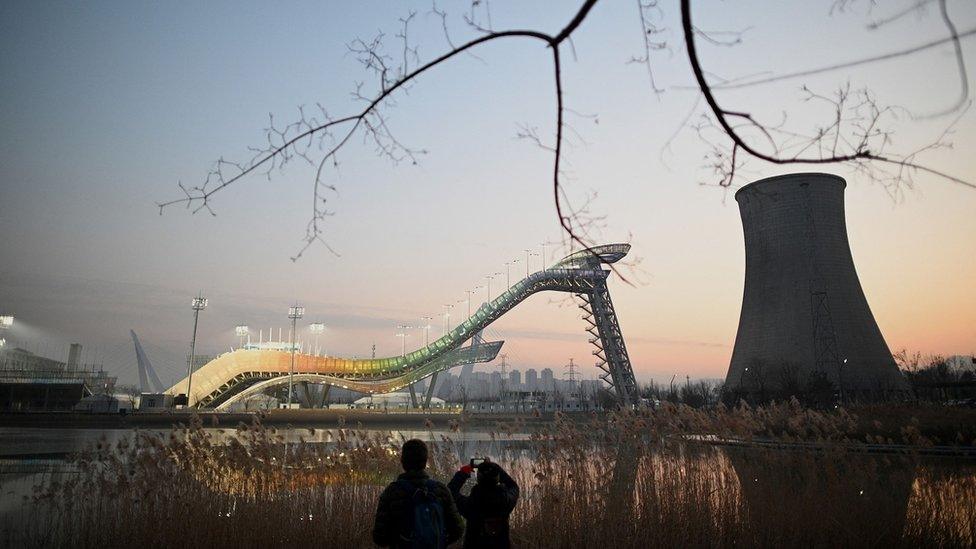Winter Olympics: Will the weather be a winner?
- Published

Shougang Park - one of the Beijing Winter Olympic Games venues
With the opening ceremony of the 24th Winter Olympic Games this week, and Beijing's average temperature in February above freezing and winters generally dry, what weather conditions might the athletes expect?
Where is it all happening?
Some of the events, such as speed skating and ice hockey, will take place indoors. The National Aquatics Centre, used in the Beijing 2008 Summer Olympics, has been converted into the "Ice Cube" in preparation for the curling competition.
But what of the outdoor events and where will they take place?
The freestyle skiing and snowboard Big Air competitions will be staged on a former steel mill site in Beijing itself.
Roughly 75km north-west of the city centre, the Xiaohaituo mountain area in north-west Yanqing, will be the setting for the alpine skiing events as well as the sliding events: bobsleigh, luge and skeleton.
The Zhangjiakou zone, approximately another 100km further on, will host the majority of the ski and snowboarding events, including freestyle, cross-country, ski jumping, Nordic combined and biathlon.
Whilst the mountains settings of these alpine events boast spectacular scenery and breath-taking runs, they lack just one vital ingredient: real snow.
Winter weather
Beijing is a city where snow and precipitation are usually hard to come by in the colder months. The winter tends to be dominated by a semi-permanent area of high pressure that feeds in cold air from Siberia.
The city typically records a maximum temperature of 6C in February and an average minimum temperature of -4C.
Zhangjiakou is a few degrees colder and gets more snow each year than Beijing since it is at a higher elevation. The average annual snowfall in the area is reportedly 63cm. Compare this with Val d'Isere in the French Alps, admittedly a higher elevation, where annual snowfall amounts are 450cm.
International Olympic Committee (IOC) officials warned in the bid evaluation report in June 2015 that the venues "have minimal annual snowfall and for the Games would rely completely on artificial snow".
Not enough snow? Fake it
The climate of the area means that organisers have to make their own snow.
Snow making machines in action at a Beijing Winter Olympic test event in November 2021
It has been calculated that Beijing 2022 will need about 49m gallons (222m litres) of water to create the required artificial snow. About 200 snow cannons are expected to blow artificial snow across the mountainside in Yanqing.
A recent report by the Sport Ecology Group at Loughborough University and Save Our Winters outlined the environmental dangers of artificial snow.
Previous winter games
The construction site of the Jeongseon Alpine Centre of the Pyeongchang 2018 Winter Olympics in South Korea
It is not the first time the IOC has chosen an alpine venue with more rock than snow.
Pyeongchang, the South Korea venue for the 2018 Winter Olympics, has a similarly cold, arid climate and also required vast quantities of artificial snow. The balmy weather for the 2014 Games in Sochi, Russia, left many athletes grumbling about slushy conditions. And even Vancouver in 2010 had to drive truck loads of snow into the melting Cypress Mountains venue.
While the focus has been on the lack of snow for these games there are other weather elements that can impact the mountain games.
Weather and forecasting
A number of events were delayed or postponed at the Pyeongchang Winter Olympics in 2018. This included the alpine skiing and snowboarding competitions, which were disrupted due to high winds.
Fog is dangerous for the Olympians and doesn't make great TV viewing either. It has led to numerous events having to be rescheduled in the past.
Organisers will hope for timely and accurate forecasts to help schedule and run the events safely. The Beijing Institute of Urban Meteorology is leading forecasting at Beijing 2022.
They will make use of sophisticated Doppler radar and more automated observation sites, with the aim of producing a high resolution forecast model showing detail down to 500m for the greater Beijing-Tianjin-Hebei (BTH) region and 100m in two small domains covering the key skiing and sliding areas.
In addition, the snow making and snow storage processes need accurate high-resolution short-term forecasting of low-level and surface temperature, humidity and wind.
Climate change means that the winter sports season is getting shorter and ski resorts are increasingly relying on artificial snow, so expect more talk about winter weather in the coming years.
- Published26 January 2022